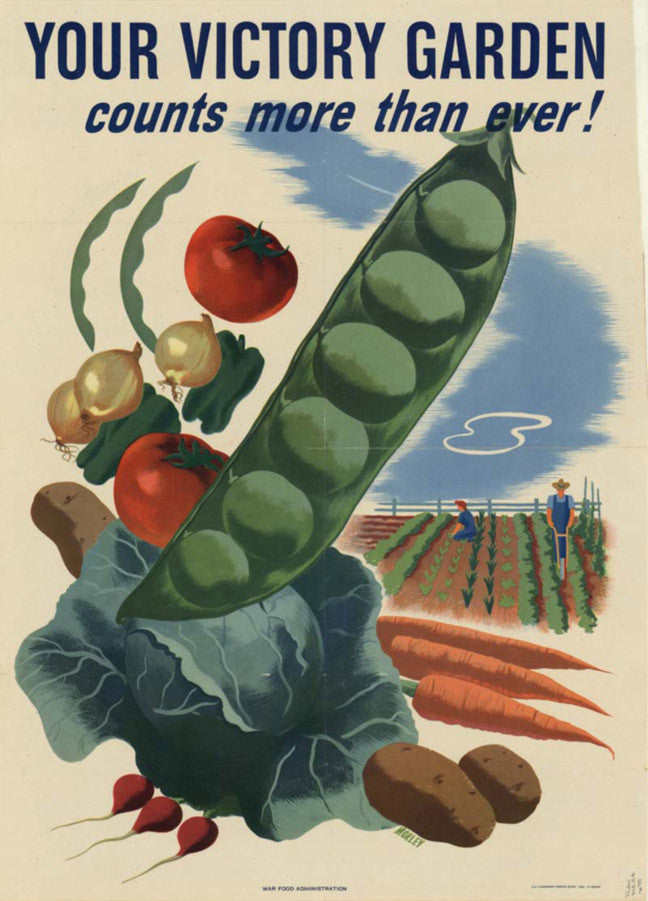2017 is the centennial of the Victory Garden. While many of us have heard this term before, some may not be overly familiar with what it really means. So let’s take a brief history lesson on the Victory Garden.
One hundred years ago, the European nations were engulfed in World War I. Many farmers joined or were recruited for military service. Their produce fields then became battlefields. As a result, a dire food crisis emerged throughout Europe. Someone needed to feed the starving people, and America took up the call. In March of 1917, the National War Garden Commission was founded. It encouraged all Americans to use whatever ground was available to them to plant and harvest their own fruits and vegetables. The produce of America’s farmers was then exported to our allies in need overseas.

The effort was a resounding success! This was in no small part thanks to the propaganda campaigns pushing civilians to “Sow the Seeds of Victory” and to be “Soldiers of the Soil”. Materials distributed by the US government offered advice to the citizenry on:
- how, when, where, and what to grow
- how to ward off unwanted insect infestations
- how to preserve surplus crops through canning and/or drying

All these combined efforts resulted in 3 million new garden plots started in 1917. That number raised to a whopping 5.2 million by the following year. There was an estimated 1.45 million quarts of fruits and vegetables canned.
By the end of WWI, the Victory Garden push by the United States government died out. But it was resurrected once the country was drawn into WWII. By 1942, the US had instituted the Food Rationing Program. This gave citizens even more incentive to provide for themselves with home grown fruits and vegetables. By 1944, an estimated 8 million tons of food was produced by Americans’ home Victory Gardens. This made up more than 40% of all the fresh produce consumed in the United States.

The end of WWII saw the push for Victory Gardens come to a close, once again. But in recent years there has been an uptick in the resurgence of them. The War Gardens in public parks from the early 20th century were reborn as Community Gardens. Neighbors can feel an increased sense of community and stewardship of the land. Along with this rebirth of a shared gardening experience came the resurgence of saving and sharing seeds. Seed saving maintains the best tasting heirloom produce for the dinner table.
Print our FREE Printable Seed Saver Packets and start saving seeds today!
Today, there is an increased desire for sustainable living. People are passionate about organic agriculture and knowing where their food comes from. Saving money, emergency food preparedness, and a self-sufficiency lifestyle are more increasingly important. These goals can be met and better controlled through the “DIY, grow your own” mentality. Off to the 21st Century Victory Garden we go!
Download our FREE Printable Canning Inventory Chart.
FUN FACT: In June of 1917, President Woodrow Wilson appointed Herbert Hoover to head the US Food Administration. It was tasked with managing America’s food reserves. Hoover urged the US people to produce more, consume less, and live simply. Propaganda posters for this effort read “Feed a Fighter: Eat only what you need. Waste Nothing, that he and his family may have enough.” Due in large part to Hoover’s actions, America avoided mandatory rationing during the first World War. This decrease in consumption came to be known as “Hooverizing”.

Shop our entire line of Victory Garden Canning Labels, Vintage Canning Labels, Kraft Canning Labels, & Canning Jar Labels on CanningCrafts.com
If you're interested in vintage victory garden posters and history, take a look at our Victory Garden Pinterest Board.
Suggested Reading List:
- Grit magazine - “A History of Victory Gardens”
- Cultivating Victory: The Women's Land Army and the Victory Garden Movement by Cecilia Gowdy-Wygant
- Fruits of Victory: The Woman's Land Army of America in the Great War by Elaine F. Weiss
- Victory Gardens for Bees: A DIY Guide to Saving the Bees by Lori Weidenhammer
This blog post does NOT contain affiliate links.







No comments:
Post a Comment